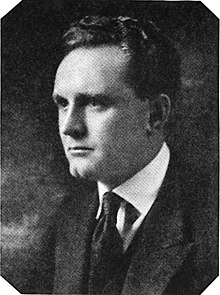|
Frank Borzage
Frank Borzage (/bɔːrˈzeɪɡi/[a] né Borzaga; April 23, 1894[b] – June 19, 1962) was an American film director and actor. He was the first person to win the Academy Award for Best Director for his film 7th Heaven (1927) at the 1st Academy Awards.[2] Born to European immigrant parents in Salt Lake City, Borzage began his career as a teenager performing with traveling theater groups throughout the western United States He found employment in Hollywood in 1912, where he began directing and acting in short films before transitioning to feature films. Borzage's other directorial feature credits include Street Angel (1928), Bad Girl (1931), A Farewell to Arms (1932), Man's Castle (1933), History Is Made at Night (1937), The Mortal Storm (1940), and Moonrise (1948). His final credited directorial work is the historical drama The Big Fisherman (1959), before his death from cancer in 1962. BiographyBorzage was born Frank Borzaga[1] in Salt Lake City, Utah in 1894, one of 14 children born to a Swiss mother, Maria (née Ruegg; 1860—1947), and an Italian father, Luigi Borzaga, a stonemason born in 1859 Ronzone (then Austrian Empire). Luigi and Maria met in her native Switzerland while she was employed in a silk factory. The couple emigrated to the United States in the early 1880s, settling in Hazleton, Pennsylvania, where Borzaga worked as a coal miner before the two married in 1883 and relocated to Wyoming before settling in Utah shortly before Frank's birth.[3] Borzage was one of 14 children, eight of whom survived childhood: Henry (1885–1971), Mary Emma (1886–1906), Bill (1892–1973), Frank, Daniel (1896–1975, a performer and member of the John Ford Stock Company), Lew (1898–1974), Dolly (1901–2002) and Sue (1905–1998). Although a Roman Catholic family, the Borzagas had a rapport with the Church of Jesus Christ of Latter-day Saints (LDS Church), and Luigi helped found several LDS temples.[4] Luigi Borzaga died in Los Angeles in a car accident in 1934; his wife Maria (Frank's mother) later died of cancer in 1947. As a child, Borzage became interested in acting, and while a teenager, took a job mining silver near Park City to save funds to attend a drama school in Salt Lake City.[5] Borzage performed in several traveling theater groups who staged plays throughout the Western United States, including in Montana, Wyoming, Colorado, and Oregon.[6] Around 1912, he joined the Gilmore Brown theater company, which led him to Los Angeles.[7] CareerIn 1912, Borzage found employment as an actor in Hollywood; he continued to work as an actor until 1917. His directorial debut came in 1915 with the film The Pitch o' Chance.[citation needed] Borzage was a successful director throughout the 1920s; he reached his peak in the late silent and early sound era. Absorbing visual influences from the German director F. W. Murnau, who was also resident at Fox at this time, he developed his own style of lushly visual romanticism in a hugely successful series of films starring Janet Gaynor and Charles Farrell, including 7th Heaven (1927), for which he won the first Academy Award for Best Director,[8] Street Angel (1928) and Lucky Star (1929). He won a second Oscar for 1931's Bad Girl. He directed 14 films from 1917 to 1919 alone; his greatest success in the silent era was with Humoresque (1920), a box-office winner starring Vera Gordon.[9][10] Borzage's trademark was intense identification with the feelings of young lovers in the face of adversity, with love in his films triumphing over such trials as World War I (7th Heaven and A Farewell to Arms), disability (Lucky Star), the Depression (Man's Castle), a thinly disguised version of the Titanic disaster in History Is Made at Night, and the rise of Nazism, a theme which Borzage had virtually to himself among Hollywood filmmakers, including Little Man, What Now? (1933), Three Comrades (1938), and The Mortal Storm (1940). His work took a spiritual turn in films such as Green Light (1937), Strange Cargo (1940) and The Big Fisherman (1959). Of his later work, only Moonrise (1948) has enjoyed much critical acclaim. After 1948, his output was sporadic, but he directed three episodes of the Screen Directors Playhouse television series between 1955 and 1956. In 1955 and 1957, Borzage was awarded The George Eastman Award, given by George Eastman House for distinguished contribution to the art of film.[11] For his contributions to the film industry, Borzage received a motion pictures star on the Hollywood Walk of Fame in 1960. The star is located at 6300 Hollywood Boulevard.[12] He was the original director of Journey Beneath the Desert (1961), but was too unwell to continue, and Edgar G. Ulmer took over.[13] Borzage was uncredited for the sequences he did direct. While hospitalized in February 1962, he received the D. W. Griffith Award.[14] He was an officer and board member of the Directors Guild of America.[15] Personal lifeOn June 7, 1916, Borzage married vaudeville and film actress Lorena "Rena" Rogers in Los Angeles and remained married until 1941. In 1945, he married Edna Stillwell Skelton, the ex-wife of comedian Red Skelton; they were divorced in 1949.[16][17] His marriage to Juanita Scott in 1953 lasted till his death nine years later.[15] He was a keen sportsman, with a 3-goal polo handicap and a two handicap in golf, and a yachtsman.[15] DeathBorzage died in Los Angeles of cancer in 1962, aged 68, and he was interred in the Forest Lawn Memorial Park Cemetery in Glendale, California.[18] FilmographyDirector
Actor
In popular cultureBorzage briefly appears as a character in Horace McCoy's 1935 novel They Shoot Horses, Don't They?, when he attends its dance marathon setting as a spectator. The narrator, Robert Syverten, notices Borzage in the crowd and has a brief conversation with him, expressing his admiration of No Greater Glory and sharing his own ambition to become a film director. Notes
References
Sources
External linksWikimedia Commons has media related to Frank Borzage.
|
||||||||||||||
